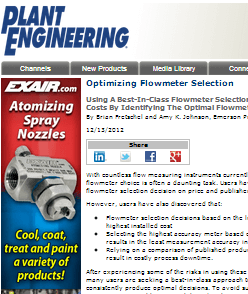 One of the challenges automation engineers face is in the selection of the best flow measurement technology for their application. Multitudes of technologies exist, each with their advantages and disadvantages. Emerson’s Brian Fretschel and Amy K. Johnson wrote an article for Plant Engineering magazine, Optimizing Flowmeter Selection, to help address these selection challenges. To improve the selection process:
One of the challenges automation engineers face is in the selection of the best flow measurement technology for their application. Multitudes of technologies exist, each with their advantages and disadvantages. Emerson’s Brian Fretschel and Amy K. Johnson wrote an article for Plant Engineering magazine, Optimizing Flowmeter Selection, to help address these selection challenges. To improve the selection process:
…a systematic repeatable approach based on best-in-class methodology is required to identify the optimal flowmeter selection in virtually any flow application.
They list the multitude of flow measurement technologies:
- Differential pressure (DP) includes orifices, venturi tubes, flow nozzles, pitot tubes, averaging pitot tubes, and V-cone
- Positive displacement includes reciprocating piston, oval gear, nutating disk, rotary vane, and diaphragm
- Coriolis (or mass flow)
- Electromagnetic
- Thermal dispersion
- Ultrasonic
- Vortex
- Turbine
Traditional selection methods typically rely on purchase price and comparison of published product specifications. Beyond the hidden installation and ongoing maintenance costs, which are not considered, the authors note that:
Changes in processes and environmental conditions may significantly affect instrument accuracy. Selecting a flowmeter rated 0.065% of span accuracy, for example, may in fact provide an actual or installed accuracy three to four times less accurate because of changes in flow rate and variations because of temperature and pressure changes… Thus, selecting a flowmeter based on purchase price and published accuracy specifications may increase operating costs and, in some cases, cause process downtime.
Brian and Amy propose a systematic, repeatable approach to the selection process. Its steps include:
- Purpose of measurement
- Flow characteristics
- Flowmeter capabilities
- External factors
- Economic factors
- Product selection matrix
Purpose of measurement:
…may include volumetric or mass flow measurement of fluids in process applications such as batching, continuous blending, control loop, custody transfer, filling, government regulations, inventory control, loading/unloading, mass balance, monitor/indicate, and safety.
For flow characteristics, it’s important to understand process conditions:
…such as pipe size; fluid characteristics such as liquid/gas/steam; whether the fluid is clean/dirty or has corrosive/erosive properties; whether the fluid’s viscosity may significantly affect flow measurement; whether operating temperature, pressure ranges, and maximum allowable pressure drop have been specified; whether the fluid has conductive/nonconductive properties; and whether flow is unidirectional/bidirectional or steady/pulsating.
The flowmeter’s capabilities must mesh with the process flow requirements. Some criteria:
…may include inline versus insertion mounting styles, local readout requirements, straight pipe length requirements, ease of engineering, configuration, installation, availability of power source, mounting in intrinsically safe areas, presence of vibrations, presence of corrosive fluids, presence of electromagnetic field, and frequency of calibration.
Examples of external factors:
…such as environmental factors, vendor capabilities, and government regulation related to potential selection criteria may include availability of service, potential of fugitive emissions of hazardous fluids, and health- or safety-related considerations. For example, reliability and environmental safety of an installation can be increased by selecting a direct-mount DP flowmeter instead of a traditional instrument that requires impulse lines.
Economic factors:
…can include quantifiable installed or lifetime cost considerations. Quantification of cost for each of the choices is done to make an objective decision by assessing an economic impact (e.g., by making a comparison of purchase price versus installed cost versus lifecycle cost of the flowmeter).
The final step involves the selection matrix with filtering criteria to remove non-suitable measurement technologies and provide an optimal list of choices to analyze. The authors caution that:
…selection process complexity will increase significantly as the number of relevant evaluation criteria and/or product selections increase.
Give the article a read to see an example of this process being applied in a custody transfer application.
If you have specific application questions, consider joining the Emerson Exchange 365 community and its flow measurement track to connect with a community of automation engineers, Emerson experts, and other interested parties.
| iTunes




